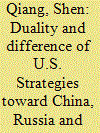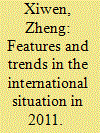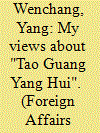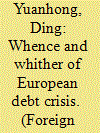|
|
|
Sort Order |
|
|
|
Items / Page
|
|
|
|
|
|
|
| Srl | Item |
| 1 |
ID:
111558


|
|
|
|
|
| Publication |
2011.
|
| Summary/Abstract |
Global governance involves worldwide redistribution of power, wealth and resources. The sole super power and other powers are focusing on the struggle between unipolarity and multipolarity. Traditional powers and emerging powers are competing against each other for power and interests. And there are ongoing conflicts among western countries and fragmentation in the developing world. China-U.S. relationship is particularly complicated, multi-faceted and ever changing. But different from its relations with the U.S., China has no direct geopolitical conflict of interests or outstanding issues left over from history in its relations with Europe. China and Europe now share increasing interests in addressing major international issues, and pursue the same or similar goals and concepts in upholding world peace and stability, in seeking to resolve international disputes through peaceful means and in reforming the international financial system. This has created broad space for China-Europe cooperation in global governance.
|
|
|
|
|
|
|
|
|
|
|
|
|
|
|
|
| 2 |
ID:
111559


|
|
|
|
|
| Publication |
2011.
|
| Summary/Abstract |
Globalization has complicated the strategic interests of major powers: integration of their strategic interests leads to their cooperation and interdependence on the one hand, and conflicts of their strategic interests result in their frictions and competitions on the other. The U.S. will try to maximize its strategic interests by utilizing its constructive cooperation with China, Russia and India on the one hand and, on the other hand, seek global and regional hegemony to contain and prevent the three countries from growing strong to become challenges to its hegemonic status. The U.S. strategies toward China, Russia and India are dual and different in degrees and contents. The U.S. will continue to hedge its bets on both the positive and negative sides of its strategies in the future.
|
|
|
|
|
|
|
|
|
|
|
|
|
|
|
|
| 3 |
ID:
111556


|
|
|
|
|
| Publication |
2011.
|
| Summary/Abstract |
The year 2011 was a turbulent one for the world. As the European sovereign debt crisis intensified, the world economic recovery lost steam. The volatility in West Asia and North Africa, with apparent international involvement, affected regional situation and geopolitical configuration. The Asia Pacific situation was in evolution and major countries increased their input in the region. The world moved further towards multipolarity. Deep-rooted problems accumulated in Western countries over the years broke out and "waves of wrath" swept across the globe. Evolution and adjustments in international and regional situation accelerated amid growing uncertainty and unpredictability.
|
|
|
|
|
|
|
|
|
|
|
|
|
|
|
|
| 4 |
ID:
111553


|
|
|
|
|
| Publication |
2011.
|
| Summary/Abstract |
The White Paper titled China's Peaceful Development is both a paper of declaration and a guideline of action for China's peaceful development. China's peaceful development is based on China's long and profound historical and cultural tradition. We have found this path in the course of the more than 60 years since the founding of the People's Republic of China, especially in the course of the great experiment of reform and opening-up. China's declaration of commitment to peaceful development is a sincere and conscientious long-term strategic choice based on China's basic national conditions. Peaceful development is a carefully considered choice based on calm analysis and sound judgment of the current situation in the world. China's declaration of peaceful development is a choice supported by firm political policies and strategies. China's exploration and practice of following the path of peaceful development will be a never-ending process of constant exploration and improvement. China's path of peaceful development involves more than China itself, and it needs the understanding, support and cooperation of the international community. China's strategic intention for peaceful development is transparent, the goal it pursues is lofty, and its policies are clear-cut. The attitude of China is sincere, its determination is firm and what China says will be honored.
|
|
|
|
|
|
|
|
|
|
|
|
|
|
|
|
| 5 |
ID:
111555


|
|
|
|
|
| Publication |
2011.
|
| Summary/Abstract |
The White Paper on China's Peaceful Development is both a candid statement of China's strategic intentions and a new strategic starting point for China's future course. For the first time ever, the white paper equates the path of China's peaceful development with the path of socialism with Chinese characteristics, explaining why China's peaceful development is essentially internally driven. By reviewing practices in the past and through theoretical innovations, the white paper establishes that the path of peaceful development is chosen based on the fundamental interests of the 1.3 billion Chinese people. China's development in each and every stage has always given new impetus to peace and development in the world. The internal driving forces behind China's development have been transformed into conditions for sustainable peace and development of the world. This path, which is unique to China and significant for the world, brims with great vitality.
|
|
|
|
|
|
|
|
|
|
|
|
|
|
|
|
| 6 |
ID:
111560


|
|
|
|
|
| Publication |
2011.
|
| Summary/Abstract |
In the new century, Latin America and the Caribbean has gradually upgraded its economic vigor and maintained a good momentum, thus laying a solid foundation for Latin America's economy. Having appropriately coped with the shocks of the international financial crisis, Latin America enjoys a favorable situation in dealing with the current external economic risks. Despite the impact of its internal structural problems and external macro environment, economic development in Latin America enjoys a favorable future. The "China factor" is playing an increasingly important role in the development of Latin America's economy. Looking ahead, China and Latin America will highly likely expand mutually complementary advantages in their economy and trade, in that the Chinese market will provide favorable external conditions for the sustainable growth of Latin America's economy and Latin American countries will in return provide more room for developing China's foreign trade and investment. More closely intertwined and integrated interests between China and Latin America represents the trend of times. It conforms to the fundamental interests of both sides to steer Sino-Latin American cooperation to a comprehensive, in-depth and sustainable development.
|
|
|
|
|
|
|
|
|
|
|
|
|
|
|
|
| 7 |
ID:
111554


|
|
|
|
|
| Publication |
2012.
|
| Summary/Abstract |
"Tao Guang Yang Hui" is an important guiding principle proposed by Deng Xiaoping for China's diplomacy in the present-day world. It has a very deep root in our traditional culture and constitutes a strategic principle we must persistently follow throughout the primary stage of socialism. For some 20 years, there have been incomplete and misguided interpretations of "Tao Guang Yang Hui" both at home and abroad. To keep following the low-key approach in our diplomatic work in the 21st century is entirely correct. "Tao Guang Yang Hui" is not outdated and will never be.
|
|
|
|
|
|
|
|
|
|
|
|
|
|
|
|
| 8 |
ID:
111557


|
|
|
|
|
| Publication |
2011.
|
| Summary/Abstract |
All major developed economies vary in the causes of their debt problems, but the nature is the same: income falling short of expenditure and spending on deficits. The root cause of European debt crisis lies mainly in the "high salary, high welfare" policy universally pursued in the European countries after WWII. The outbreak of global financial crisis became the fuse to the European debt crisis. The economic scales of Greek, Ireland and Portugal troubled by debt problems are not very large. Their debt problems constitute not much risk to the EU. But the European debt crisis has been turned into a hubbub. This is not only because the defects of the EU policy-decision mechanism have provided the public with an opportunity to play up the problem, but also because the US attempts, by speaking ill of the Euro, to resist the pressure from the European side demanding reform of the world financial system dominated by the US dollar. As a matter of fact, the US economic situation is no better than Europe's. Its debt burdens are also heavier than Europe's. Therefore, although European economic recovery will take a considerably long period, the Euro will not "collapse" and the Euro zone will continue to exist. The EU will remain the largest economy in the world.
|
|
|
|
|
|
|
|
|
|
|
|
|
|
|
|
|
|
|
|
|